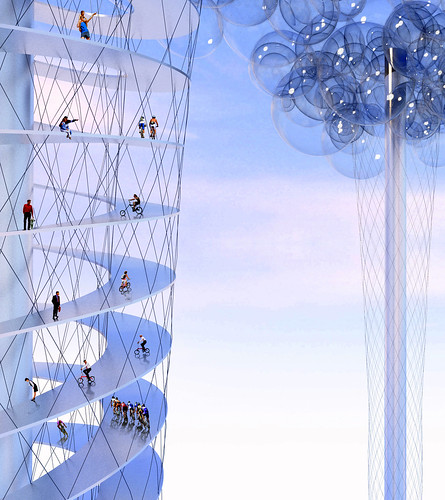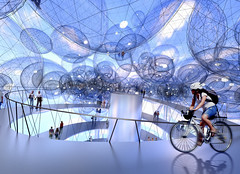

EVOLUTION
The history of Olympics and Expos is one of heaviness - of mass and monumentality and conspicuous expenditure on immovable objects. Our most extraordinary contemporary feats of engineering are more stealthy, more extensive and more invisible than these traditions of glass and brick and steel: Code rather than Carbon.FORM
The structure is comprised of a filigree central array of columns - serving as circulation systems dropping from the sky.PEOPLE
People can choose to ascend to the Cloud by foot or bicycle - gaining the status of everyday Olympians, each individual footstep contributing to a vast collective energy-harvesting effort.FUNDING
Everyone from around the world will be able to contribute to the Cloud - whether through the admission charges and bodily presence of their visit, or by their contributions towards a particular sphere and their ownership of a single LED, helping to keep the lamp of London aflame.ENVIRONMENT
The Cloud addresses our twin attention spans of the short-term desire for information and stimulation, and our growing longer-term consciousness about our impact on the future, and our productive role within a larger harmonious ecology. It provides two resources - energy and data - harvesting both the natural ecosystem and humanity's complementary cyber-sphere, fusing the two.INFORMATION
Like all tell-tale signs of brooding weather, the Cloud is a display system. It is both screen and barometer, archive and sensor, past and future. The patterns of its animated skins offer a civic-scale smart-meter for London as a whole, sign-posting particular events, transport patterns, weather forecasts, timetables, and footage either real-time or decades old. Its movements can reveal the movement of both the crowds below and those within its structure - a space alive to the touch, an aerial ecology.Overview
MIT News Office
A CLOUD THAT TWEETS
Proposed monument for London 2012 Olympics unveiled
A team of leading architects and engineers has just unveiled designs for The Cloud - a landmark structure to commemorate London's role as host of the 2012 Olympics. The lightweight transparent tower, composed of a "cloud" of inflatable, light-emitting spheres, would create a spatial, three-dimensional display in the skies of London, fed by real time information from all over the world. The structure is "a new form of collective expression and experience and an updated symbol of our dawning age: code rather than carbon," said Carlo Ratti, head of the MIT SENSEable Cities Laboratory and one of the project leaders. Other members of the design team include artist Tomas Saraceno, digital designer Alex Haw, lightweight-structures expert Joerg Schleich, engineering group Arup, landscape architects Agence Ter and the Internet company Google. Those advising the team include writer Umberto Eco and and MIT professor and artist Antoni Muntadas. "Our main idea is to apply to architecture some of the distributed processes that are currently revolutionizing the digital world," says Professor Ratti. "For instance, we would like the Cloud to become a symbol of global ownership built through a bottom up fundraising effort." The size of the Cloud will not be set in advance, but it will evolve based on the level of contributions received. The global "cloudraising" effort will be supported by platforms such as Facebook and Twitter; Google will provide advertising on YouTube and in search results. "We look forward to applying lessons learned from the Obama campaign to involve the global community in support of the Cloud", said Margo Miller, immediate past Chair of Democrats Abroad UK. The Cloud will also be "a vast, collective energy-harvesting effort," explains Alex Haw. People can choose to ascend the Cloud on foot or bicycle; the energy that it would take to descend the Cloud is converted, on the way down, into electricity through elevators with regenerative breaking, similar to those that are present in hybrid cars. "The people's energy, coupled with solar energy collected through on-site and off-site photovoltaic cells and various energy saving strategies will allow us to reach carbon neutrality, whereby the Cloud produces all the energy it uses."
The structure of the Cloud is an innovation in and of itself. "Many tall towers have preceded this, but our achievement is the high degree of transparency, the minimal use of material and the vast volume created by the sphere - all on exceedingly slender columns, stabilized by a cable net such as the one I built in Stuttgart in 2001", commented professor Joerg Schleich. "The Cloud is a delicate yet robust filigree of reliable high-tech components, its ingredients familiar, their composition radically new."
The LEDs in the Cloud, fed by real time information, will be viewable from all over London - something which was of particular interest to Google. "When Carlo Ratti approached our founder Larry Page, we chose to collaborate because of his bold and visionary concept, and because the project fit with Google's mission of organizing the world's information and making it universally accessible and useful," explain Obi Felten and Matt Brittin, Managing Director of Google UK. "We
particularly like the idea of the Cloud in the sky above London displaying information to the city and beyond - a powerful symbol for the openness and diversity of London, befitting the first truly digital Olympics." Moving inside the Cloud will be like floating inside a three-dimensional display, animated by information feeds that could include energy use, spectator numbers, decibel levels, medal updates, transport patterns, mobile phone activity, Internet traffic, and others. "The Cloud develops our ongoing interest in the idea of the 'civic-scale smart meter', acting as a real-time feedback loop on collective urban activity," said Dan Hill from Arup. The Cloud was initially designed for the 2012 Olympic Park, although other sites in London are also currently being explored. The team states that no public funding will be required. "We can build our Cloud with 5 million pounds or 50 million," says team member Walter Nicolino. "The flexibility of the structural system will allow us to tune the size of the Cloud to the level of funding that is reached." The Cloud team at the MIT Senseable City Laboratory is composed of Carlo Ratti, Assaf Biderman, Mauro Martino, E Roon Kang, working together with Walter Nicolino and Giovanni de Niederhausern. The Cloud team includes artist Tomas Saraceno, digital designer Alex Haw, lightweight-structures expert Joerg Schleich, engineering group Arup, landscape architects Agence Ter, graphic designers Studio FM, visualization experts GMJ. Advisors to the team include Umberto Eco, Marco Santambrogio, Chris Bangle, Giuliano da Empoli, Antoni Muntadas, William Mitchell, Paul Richens, Gianluca Salvatori, Caterina Ginzburg, Liza Fior, Margo Miller.

No comments:
Post a Comment